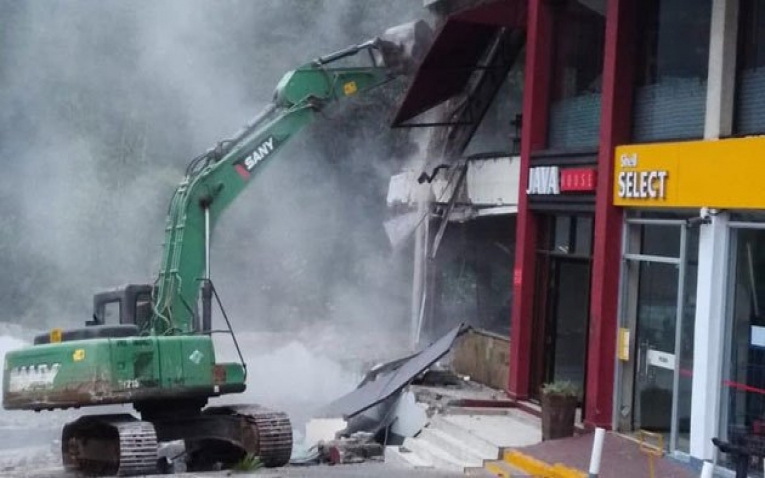Land matters in Kenya are a hot button issue. Last year we were treated to incredible scenes of tall buildings that had been built on riparian land coming down in dramatic fashion and reduced into rubble and smithereens. The bulldozers that were responsible for the destruction were christened either ‘green mamba’ or ‘Sany the exterminator’ owing to their green color and make respectively.
This article is not about building on riparian land or how you can defy nature by altering the course of a river at your own expense (as a governor who must not be named would say) but on another overlooked factor that developers often ignore before embarking on construction. That is beacon confirmation and re-establishment.
Kenyans are attached to the ka-plot mentality with good reason because the cost of land seems to be going up and up. It appears to be an investment that one can bank on to increase in value. I’ve heard some experts say that it’s a bubble that will burst soon but this soon seems to be taking forever. As for now, buying a plot of land either for investment or speculation has been the norm for Kenyans for a number of years now.
Since a good number of people do not develop their plot of land right off the bat after purchasing it, a few things are likely to happen. Your plot beacons could be destroyed or moved by unscrupulous neighbors with the ill motive of encroaching on your land. The second and most common scenario is that your beacons could get lost. This means that even though you have a good idea about the plot’s location, you can’t physically identify your beacons.
In my land survey practice, I’ve learnt one very important rule of thumb. If you can’t locate your beacons, don’t construct. I’ve witnessed people who were forced demolish a wall or a room of their dream home or changing their architectural plan altogether because they had encroached marginally on the neighbors plot. This is all because the owners did not do the due diligence of confirming their beacons and hence embarked on construction without knocking off this detail off their checklist.
I sense a question running in your mind. How do beacons get lost? Well, if you live your land idle month upon month and year upon year, the beacons might be buried by runoff soil and new grass or carried away altogether by flood water as the weather keeps changing. Another reason is that some scrap metal dealers often mutilate beacons to get hold of the iron pin for reselling. Also during road construction, a bulldozer can inadvertently disturb a beacon position rendering it useless for the purpose it was intended.
In some cases, finding a lost beacon is not a difficult task. It could involve digging and locating the Iron Pin in Concrete (IPC) without much hustle. However, most are the times when the owner has no clue where he last saw the thing. This is the time to call upon a professional and ethical land surveyor to locate the IPC’s for you. It is not an expensive affair and it will give you the reassurance that you’re not encroaching on anyone’s land.
Are land surveyors trained to ‘smell’ beacons? No we don’t, but if wishes were horses I wouldn’t mind having the gift. A beacon is a parcel boundary identifier that is protected by law. Each beacon possesses a unique position on the earth’s X and Y axis (Co-ordinates). All parcels and their coordinates are stored in records either at Survey of Kenya or the local lands office. So re-establishing a beacon is not a matter of the senses but the good old-fashioned way of doing mathematical calculations involving angles and distances.
Needless to say, destroying a beacon is a felony. A party that destroys your beacon for the purpose of encroaching on your land will be in serious trouble if you can prove your case in court. In fact if the evidence is beyond reasonable doubt it is normally an open and shut case. That is why surveyors take the trouble of buying survey plans from the lands office and carry with them Total Stations (camera looking equipment) and geodetic GPS equipment to try and locate the beacons after serious mathematical calculations.
A good beacon confirmation and re-establishment should be able to tell the true area of your land as indicated in your title deed, deed plan or any other ownership document in your possession. Some parties go a notch higher and ask for a beacon certificate from the surveyor. A beacon certificate is a document anchored in the Survey Act declaring that the surveyor has placed beacons, that he has full knowledge of the positions of the said beacons and that he is satisfied that such define the boundaries of the parcel in question.
So, next time you embark on a construction job and the client is in a fix about the position of his beacons or parcel boundaries, don’t wish the issue away and say it is not part of your job description (or JD as we say in the office). Suggest to the client to seek the services of a land surveyor, duly trained and qualified. It might save your client millions of shillings in damages by keeping ‘Sany the exterminator’ away.




